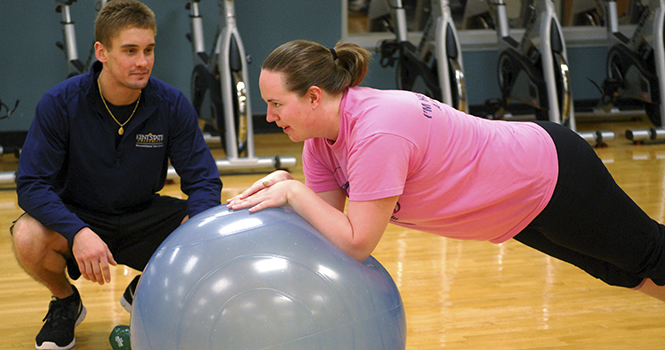Students can learn how to properly work out with personal trainers
Jerry Guerriero, a personal trainer at the Kent State Rec Center, works with Rebecca Kapler during a short training session Friday, October 11 2012. Photo by Melanie Nesteruk.
October 15, 2012
The Department of Recreational Services offers personal training services for anyone to purchase who wants help to fulfill their fitness goals and needs.
Personal training is a private, one-on-one session with a certified trainer. Personal trainers design and implement customized exercise programs based on a participant’s fitness desires.
Determining fitness before training
Before a client can purchase a personal trainer, he or she has to get a fitness assessment, which tests all components of fitness. A fitness assessment costs $20 and tests a client’s fitness level in the following areas: body composition, muscular strength and endurance, aerobic capacity and flexibility. A print-out is then given to the client, comparing him or her to people of the same age. The print-out shows what percentile a client is in his or her age range.
“I like that fitness assessment because it shows where a client has to start to get into better shape,” senior trainer Jerry Guerriero said. “It also is good for body maintenance because you can pinpoint possible health issues before they happen.”
Rebecca Kapler, commuter services coordinator for the Center of Student Involvement, has been training with Guerriero since July. As part of the program, Kapler seeks nutrition counseling.
“I still go and see the nutritionist once a week since it is free,” Kapler said. “With the nutritionist’s help, I have adjusted my diet to complement my workouts.”
Guerriero said diet is the most important aspect of getting in shape.
“I always say you can’t get fit in the gym until you adjust what is in the kitchen,” Guerriero said.
Choosing a trainer
Once a client has finished the fitness assessment, a three-day diet analysis or nutrition counseling, he or she can hire a personal trainer. A client can look through the personal trainer bio book to see what each trainer’s specialties are, or a trainer can just be placed with a client randomly because he or she has times slots open that fits the clients schedule.
Most trainers at the Rec are senior trainers. There is one master trainer who deals with special populations such as people with joint problems or clinical conditions. Guerriero uses circuit training.
Kapler said she hired Guerriero to help improve her exercise techniques.
“I wanted to get back into shape,” Kapler said. “I hired Jerry because I wanted to learn exercises, and the proper weight-lifting techniques so I don’t get hurt.”
Paying for a personal trainer
Guerriero said he has clients from the age of 18 to 53. The price for 10 sessions at the Rec is $247 for students.
Bobby Hegedish, sophomore communication studies major, said he likes having a personal trainer to push him to his limits.
“I’m a college student who has only a certain amount of money to live on for the year,” Hegedish said. “Even though I don’t have much money, I am willing to pay for a personal trainer because I want to see how far I can keep pushing myself. A personal trainer is there to keep me in line with my goals and push me past them.”
Kapler also said a personal trainer is worth the cost.
“Paying the price for a personal trainer was never an issue for me because it is worth it,” Kapler said. “It is something I do for myself. Paying for training sessions makes sure I’m here at 6 a.m. to get in the good workout that I need.”
Contact Breanna Reffel at [email protected].

























